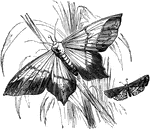
Swallow-Tailed Moth
The swallow-tailed moth (Ourapteryx sambucaria) and the many-plumed moth (Ourapteryx hexadactyla).

Bacon Beetle (Dermestes Lardarius)
"They eat bacon, skins, and also attack each other. The perfect insect does no damage. Insects in this…
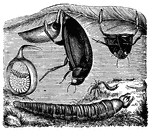
Hydrophilus Piceus
"It is common in fresh waters. It must not be seized without taking precautions, as its breast is provided…

Bristles at the Extremity of the Abdomen of the Hydrophilus Piceus
"The female is sometimes seen clinging to aquatic plants head downward, forming her cocoon, terminated…
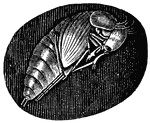
Pupa of the Hydrophilus Piceus
"At the end of two months the larva comes out of the water and burrows into the ground to undergo its…

Dyticus Marginalis (Male)
"The most common species of the Dytici, or Water Beetles. They sometimes attack the Hydrophilus…

Dyticus Marginalis (Female)
"The most common species of the Dytici, or Water Beetles. They sometimes attack the Hydrophilus…
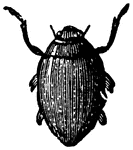
Gyrinus Natator
"They swim rapidly, describing incessantly capricious circles. These movements have gained for them…

Larva of Gyrinus Natator
"They swim rapidly, describing incessantly capricious circles. These movements have gained for them…
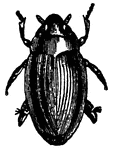
Gyrinus Striatus
"The Gyrinus Striatus is found in the waters of Southern Europe. These insects are all small,…

Gyrinus Distinctus
"A distinct species, which exists in a little lake of mineral waters in France, where visitors amuse…

Golden Ground Beetle (Carabus Auratus)
"Abounds in trees and gardens. When it is touched it disgorges a black and acrid saliva, and ejects…

Carabus Canaliculatus
"Abounds in trees and gardens. When it is touched it disgorges a black and acrid saliva, and ejects…

Pupa of Calosoma Auropunctata
"A very beautiful specimen of this tribe may be found in June on oak-tees."
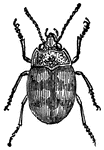
Omophron Libatum
"They are small almost globular, of a pale yellow with green lines, an live in sand bordering rivers."

Nebria Arenaria
"They are small almost globular, of a pale yellow with green lines, an live in sand bordering rivers.…

Campylocnemis Schroeteri
"An Australian insect, of a bright black, which attains to more than an inch and three quarters in length,…

Harpalus Aeneus
"The innumerable tribe of Harpalidae (or Harpalinae) contains carnivorous beetles of very small size.…

Larva of Galerita Lecontei
"The innumerable tribe of Harpalidae (or Harpalinae) contains carnivorous beetles of very small size.…

Larva of Mormolyce Phyllodes
"The innumerable tribe of Harpalidae (or Harpalinae) contains carnivorous beetles of very small size.…

Tiger Beetle (Cicindela Heros)
"Their ferocity is remarkable. They quickly tear off the wings and legs of their victim, and suck out…
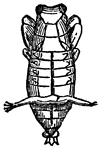
Upper Side of Pupa of Tiger Beetle (Cicindela Heros)
"Their ferocity is remarkable. They quickly tear off the wings and legs of their victim, and suck out…

Under Side of Pupa of Tiger Beetle (Cicindela Heros)
"Their ferocity is remarkable. They quickly tear off the wings and legs of their victim, and suck out…

Ctenostoma Rugosa
"According to a traveler, the women of Egypt eat these cooked with butter to make them fat. They are…
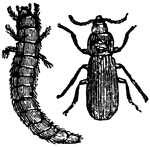
Tenebrio Molitor (Larva and Imago)
"A blackish-brown insect. The larvae are the well-known meal-worms, which live in flour."
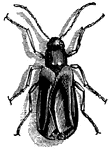
Sitaris Humeralis
"The female Sitaris Humeralis lays at the entrance of the nest of a solitary bee from 2,000…

First Larva of Sitaris Humeralis
"A month afterward there come out of these eggs very small larvae, of a shining dark green, hard-skinned,…

Pseudo Nymph of Sitaris Humeralis
"When the male bees have built the cells and furnished them with honey, the female, as we know, deposits…

Third Larva of Sitaris Humeralis
The second larva stage lasts for 6 weeks. It contracts and passes through the winter. "In the spring…

Pupa of Sitaris Humeralis
The second larva stage lasts for 6 weeks. It contracts and passes through the winter. "In the spring…

Male Lampyris Noctiluca
"It has the power of making its natural torch shine or disappear at will. The luminous properties with…

Female Lampyris Noctiluca
"It has the power of making its natural torch shine or disappear at will. The luminous properties with…
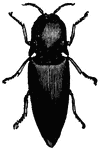
Cucuyo (Pyrophorus Noctilucus)
"An insect very common in Havana, Brazil, Guiana and Mexico. It may be seen at night in great numbers…
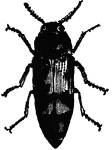
Buprestis (Cyria) Imperialis
"It is very rare in northern climates. It may be found on birch trees. In the hottest parts of the world…

Hylesinus Piniperda
"All vegetables, the vine, fruit trees, the ash, pine, etc., are eaten by some weevil or other."
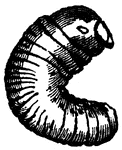
Larva of Scolytus
"Sometimes this larva destroys great forests of oak trees. In 1783, in the Forest of Hartz, 1,500,000…

Stick Insect
The Phasmatodea (sometimes called Plasmodia) are an order of insects, whose members are variously known…
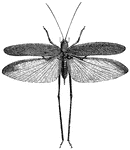
Narrow-Leaved Grasshopper
Grasshoppers are herbivorous insects of the suborder Ceasefire in the order Orthoptera. To distinguish…

Oblong Leaf-Winged Grasshopper
Grasshoppers are herbivorous insects of the suborder Ceasefire in the order Orthoptera. To distinguish…

Ichneumon Fly
The Ichneumonoidea are insects classified in the hymenopteran suborder Apocrita. The super family is…

Pupa
Illustration of a pupa attached to a wall. A pupa (Latin pupa for doll, pl: pupae or pupas) is the life…

Pupa
Illustration of a pupa attached to a leaf. A pupa (Latin pupa for doll, pl: pupae or pupas) is the life…
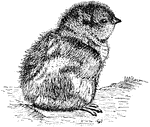
Young Grouse
Grouse are a group of birds from the order Galliformes. Often considered a family Tetraonidae, the American…

Cricket
Crickets, family Gryllidae (also known as "true crickets"), are insects somewhat related to grasshoppers…

Aphid
Aphids, also known as plant lice, are small plant-eating insects, and members of the superfamily Aphidoidea.…
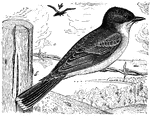
Kingbird
The genus Tyrannus is a group of large insect-eating birds in the Tyrant flycatcher family Tyrannidae.…
Woodpecker Tongue
An illustration of a woodpecker's tongue. The long sticky tongues, which possess bristles, aid these…
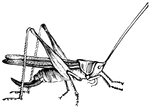
Cricket
Crickets, family Gryllidae (also known as "true crickets"), are insects somewhat related to grasshoppers…
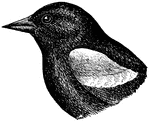
Red-winged Blackbird
The Red-winged Blackbird (Agelaius phoeniceus) is a passerine bird of the family Icteridae found in…

Red-winged Blackbird (Female)
The Red-winged Blackbird (Agelaius phoeniceus) is a passerine bird of the family Icteridae found in…
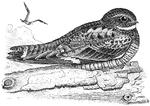
Nighthawk
Nighthawks are birds of the nightjar family in the New World subfamily Chordeilinae. They are medium-sized…

Phoebe's Nest
An illustration of a Phoebe's nest in a box. The genus Sayornis is a small group of medium-sized insect-eating…

Cochineal
An illustration of Cochineal living on cactus. Cochineal is the name of both crimson or carmine dye…
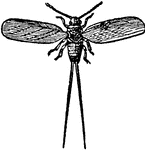
Cochineal (Male)
An illustration of a male Cochineal. Cochineal is the name of both crimson or carmine dye and the cochineal…





